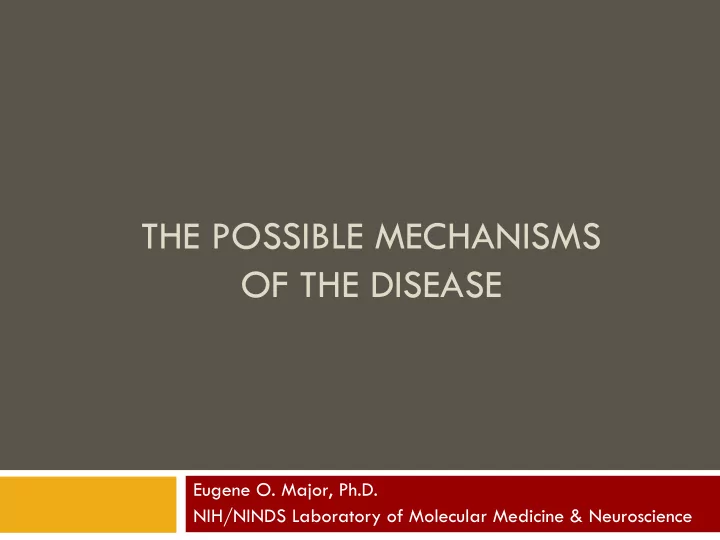

THE POSSIBLE MECHANISMS OF THE DISEASE Eugene O. Major, Ph.D. NIH/NINDS Laboratory of Molecular Medicine & Neuroscience
Laboratory of Molecular Medicine and Neuroscience Division of Intramural Research, NINDS LMMN Members Karen Augustine Maria Barhams, M.H.S.A. Beth Daley Linda Durham, M.S. Mike Ferenczy, Ph.D. Paul Howell Carol Ibe, M.S. Peter Jensen Zhi-Gang Jiang, M.D., Ph.D. Eugene O. Major, Ph.D. Leslie Marshall, Ph.D Matt Mirsky Maria Chiara Monaco-Kushner, Ph.D. Caroline Ryschkewitsch, M.T.
PML is a viral-induced demyelinating disease 3 Prevalence classifies PML as rare disease (fewer than 200,000 cases in the US*); no known animal viral reservoir Lytic infection of oligodendrocytes (necrotic; lytic cell death; progressive, slow release of virus intercellular- no burst of virus) Cerebral hemispheres and cerebellum with no evidence for spinal cord involvement or optic nerve Multifocal, acute and persistent Latent in several tissue compartments (ie. kidney and immune system) Immune system dysfunction (suppression/modulation) No effective therapies other than ‘intact’ immune clearance * NIH Office of Rare Disease Research
JC Virus Characteristics 4 JC viral genome: *Early (T-protein) *Regulatory Region (non- coding promoter enhancer) *Late VP1,2,3(capsid proteins) Virions in PML lesions Virion particle
Progressive Multifocal Leukoencephalopathy in Patient Populations 5 HIV/AIDS Autoimmune Diseases Multiple Sclerosis Crohn’s Disease Rheumatoid Arthritis Systemic Lupus Erythematosus Neoplastic Diseases Organ Transplant Patients
Progressive Multifocal Leukoencephalopathy Incidence 6 Alters B and T cell functions PML Multiple PML 1/100 HIV 1/100 HIV immunosuppressive immune immune agents suppression viral suppression viral factors factors Alters B and T cell functions Research Question: What is the link between immune-suppressive agents or monoclonal antibody therapies that results in development of PML? Are there different mechanisms for pathogenesis? Is PML the same disease regardless of underlying disease?
Tissues Correlating with JC Virus Presence in Brain 7 Possible Pathway Bone Marrow (pre B cell?) Kidney* Peripheral Blood (B cells) Brain (Oligodendrocytes) Reference: Brew, et al. (2010) Progressive Multifocal Leukoencephalopathy and other JC virus diseases. Nat Rev Neur 6, 667-679.
Pathogenic Mechanisms in Patient Populations 8 Factors favoring development of PML Factors favoring development of PML Lack of immune surveillance (T cell) Cellular immune response against the virus (functional/ineffective) Humoral immune response (unknown role of antibody) Virus reactivated from latency in peripheral compartments that are affected by alterations of immune function i.e. natalizumab, rituximab, efalizumab; ‘stochastic event’ but linked with mechanism of immune modulation/suppression ( no data suggest that therapies assist in establishment of viral latency ) Different mechanisms for viral reactivation depending upon patient history and treatment for underlying disease; HIV infection differs from Mab treatments differs from small molecule drugs like mycophenylate.
Traffic of Virus to Brain 9 Traffic of virus to the brain following release of virus from sites of latency (initial infection also possible but rare; initial site of infection is unknown but thought to be common site following respiratory inhalation or ingestion. Potential Methods: Immune system cells (CD34+,CD10, CD19/20) Free Virus Kidney (release virus into peripheral circulation) Latency in the brain (under investigation)
Hypothesis 10 Coding sequences for viral capsid protein Non-coding regulatory sequences show VP1 can be altered following latency direct tandem repeat structures in pathologic tissues compared with kidney (no repeats)
In Summary… 11 Occurrence of Occurrence of Progressive Progressive Therapies for Therapies for Multifocal Multifocal underlying disease underlying disease Leukoencephalopath Leukoencephalopath y y There is a ‘ direct link ’ between immune modulatory agents and PML HIV-1/AIDS > Integrin inhibitors Natalizumab (Efalizumab) > Rituximab > Small molecules
Recommend
More recommend